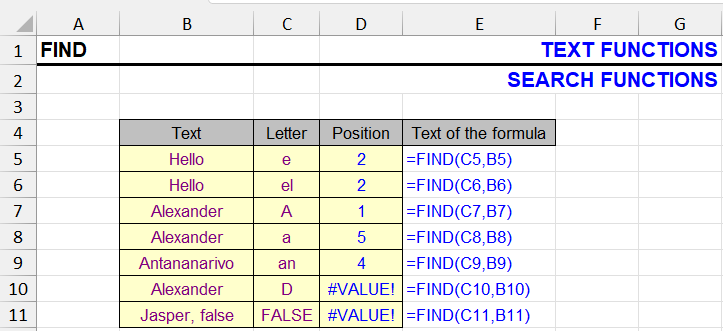
| Function category | Text |
| Volatility | Non-volatile |
| Similar functions | SEARCH, Find and Replace (procedure) |
What does the FIND function do?
This function searches for text within another text fragment using case-sensitive search. This distinguishes it from the SEARCH function, despite having an absolutely identical syntax. The second difference – it doesn’t support wildcard characters, treating them as regular characters.
When the search text is found, its position in the text is displayed as a number. If the text contains more than one occurrence, the position of the first one is output.
The third optional parameter is used to find a fragment starting from a specific position in the text.
If the search text is not found in the text, the function returns a #VALUE! error.
FIND – Function syntax
Syntax of the “FIND” function:
=FIND(Find_Text, Within_Text, Start_Position)Formatting
See SEARCH function
FIND function – examples
If case is not important, it’s better to use the SEARCH function and take examples from there.
Find uppercase letters (Cyrillic and Latin)
The function is case-sensitive, which allows using it, for example, to find uppercase letters in Excel. The solution below, however, is not the most elegant, there are simpler options (in the article via the link).
=COUNT(FIND({"A","B","C","D","E","F","G","H","I","J","K","L","M","N","O","P","Q","R","S","T","U","V","W","X","Y","Z","А","Б","В","Г","Д","Е","Ё","Ж","З","И","Й","К","Л","М","Н","О","П","Р","С","Т","У","Ф","Х","Ц","Ч","Ш","Щ","Ы","Э","Ю","Я"}, A1)) > 0Find uppercase English letters in a cell
You can use an analog of the formula above by removing Cyrillic from it, but you can also use a more elegant array formula.
The COUNT function and CHAR function will help compose such a formula:
{=COUNT(FIND(CHAR(ROW(65:90)), A1)) > 0}The formula will also return TRUE or FALSE.
Important: the array formula is entered without curly braces using the Ctrl + Shift + Enter key combination.
Find uppercase Russian letters in a cell
The formula is similar to the previous one, the only difference is in the character range – from 192 to 223:
{=COUNT(FIND(CHAR(ROW(192:223)), A1)) > 0}See also:
Find specific characters in Excel cells
Find numbers/digits in Excel text
Like the article? Help its author! Buy !SEMTools, it has lots of useful instruments to process text data.